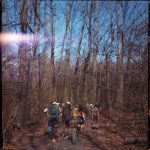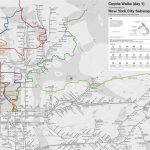“Walk a Mile in her Veil is an introspection of Arab identity through the lens of the veil and its user, inviting visitors to try on the veil and understand first-hand the cultural, social, and feminist motives behind it.” [credit]
Category Archives: Urban
Jennie Savage, The Guide to Getting Lost (2014)
“The Guide To Getting Lost is a 30 minute audio guide by artist Jennie Savage. This audio walk invites you to become lost in your familiar geography and the fictional sonic landscape of the audio guide, where you will encounter street markets, shopping malls, beaches and birdsong recorded in enigmatic locations. The artist’s instructions to walk are the same for everyone, however each of us will interpret the directions, walk at a different pace, become lost in familiar territories and, of course, inhabit different landscapes and make choices about how closely to adhere to the directions; do you turn left into private property or choose to take the next familiar turning?” [credit]
Stalker Collective (1995-), Rome, Italy
“Stalker is a collective of artists and architects, founded in 1995 in Rome, Italy, focused on local research and activities, with particular attention to marginal areas, mainly urban voids and spaces in transformation. Their practice is based on urban explorations, listening and interactions that enact a creative flow within the investigated area, its people and their collective memory and imagination. These processes aim at generating social and environmental relationships capable of self-organizing themselves and evolving. The activities of Stalker promote sharing of knowledge, collaborations and awareness-raising inside different communities towards their territory and their cultural environment.” [credit]
The 1996 Stalker Manifesto (by Lorenzo Romito) is available at the end of Walkscapes: Walking as an Aesthetic Practice (2017). Stalker proposes the transurbance as a means of mapping the unique spatial and social conditions of the contemporary city.
Article about “EUR(H)OPE Charade,” Hidden Histories 2021, Roma
“Stalker is a collective of architects and researchers connected to the Roma Tre University who came together in the mid-1990s. In 2002, Stalker founded the research network Osservatorio Nomade (ON), which consists of architects, artists, activists and researchers working experimentally and engaging in actions to create self-organised spaces and situations.
Stalker have developed a specific methodology of urban research, using participative tools to construct a ‘collective imaginary’ for a place. In particular they have developed the method of collective walking to ‘actuate territories’, which for them is a process of bringing space into being. Stalker carry out their walks in the ‘indeterminate’ or void spaces of the city, which have long been disregarded or considered a problem in traditional architectural practice. Referring to their walking practice as ‘transurbance’, the group views it as a collective mode of expression and a tool for mapping the city and its transformations, of gathering stories, evoking memories and experiences, and immersing themselves with others in a place. They use this knowledge and experience to address urban planning and territorial issues, focusing especially on the interstices of the contemporary city-region. Starting with the edges of the Tiber river on the outskirts of Rome, Stalker have since used this method in many other cities including Milan, Paris, Berlin and Turin.” [credit]
“Since their early walks, Stalker/ON have developed an approach to architecture that is profoundly participatory. Using tactical and playful interventions, they aim at creating spatial transformations through engaging in social relations, because as they have observed, the built environment takes too long to respond to the needs and desires of those who inhabit it. Places on the periphery and communities that are marginal take centre stage in Stalker/ON’s projects, working with amongst others the Roma and gypsy populations of Europe, Kurdish migrants and the homeless. Their projects show a commitment to those that society abandons and their method collectively tries to build projects with them. Through listening, making use of creative tools of mapping, walking, interventions and participation, Stalker/ON initiate processes of self-organisation that create convivial, social spaces.” [credit]
Other Work
- Francesco Careri, “Transborderline,” Architectural Design 71, no. 3 (2001): 87-91.
- —, Walkscapes: Walking as an Aestheic Practice (Barcelona: Gustavo Gili, 2003).
- Francesco Careri and Lorenzo Romito, “Stalker and the Big Game of Campo Boario,” in Architecture and Participation, ed. Peter Blundell Jones, Doina Petrescu, and Jeremy Till (Abingdon: Spon Press, 2007), 249-256.
- Peter Lang, “Stalker on Location,” in Loose Space, ed. Karen A. Franck and Quentin Stevens (New York: Routledge, 2001).
- Lorenzo Romito, “The Surreal Foil,” Architecural Design 71, no. 3 (2001): 20-23.
- “Stalker – Laboratorio d’arte urbana – Roma,” StalkerLab, www.stalkerlab.it.
References About
- “Stalker/Osservatorio Nomade,” Rhiz.eu, http://www.rhiz.eu/institution-30469-en.html.
- “ON – Osservatorio Nomade – Stalker: Immaginare Corviale, Rome, Italy 2004-2005,” A + U: Architecture and Urbanism (2005).
Quotes
ON/Osservatorio Nomade is an interdisciplinary research project initiated and promoted by Stalker, which proposes ways of interventions based on spacial practices of exploration, listening, and ralation, activated through creative tools of interaction with the environment and the inhabitants and with the archives of memories. Such practice aims to catalize the development of self-organized evolutive processes, through the establishment of social and environmental relations. The interventions build up a sensible, complex and dynamic mapping of territories and communities, through an interdisciplinary approach, activating interest and easly accessible. Such operative practice is a unique tool for knowledge sharing and contributes to the dissemination and widening of communities conciusness towards their territory and cultural environment, able to draw effective feedbacks through creative participation in territorial and urban management.
– Stalker/ON website, http://www.osservatorionomade.net
Stalker’s fundamental thesis for their manifold interdisciplinary strategies is that architecture, as a solid mass, cannot “change as quickly as the community that lives within it”. That is why they are pursuing the route of participative work with the residents in order to initiate a process that will produce an adaptive understanding of architecture and urban planning – through a community that is interested in their buildings and in the opportunities for adapting them.
– Urban Drift, Talking Cities (2006), http://talkingcities.org/talkingcities/pages/180_en.html
The idea is to rediscover, in the metropolitan territory, a sense that springs from the experience of the present state of things with all its contradictions, from an unopinionated perspective, free of reassuring and at the same time frustrating historical or functional justifications.
– Francesco Careri, Walkscapes: Walking as an Aestheic Practice (Barcelona: Gustavo Gili, 2003); see also www.stalkerlab.it
Giulia Fiocca
Architect, independent researcher and activist on urban and social trasformation focusing on the marginal realities and communities, leftover spaces, informal urbanism and self-organised social and cultural practices. Based in Rome. Studies among Rome, Vienna and Barcelona (Master ‘Metropolis’ in Architecture and Urban Culture at UPC). Since 2006 part of Stalker/Osservatorio Nomade partecipating several projects: Campagnaromana (2006), Rieres//Rambles in Barcelona (2006), Campus Rom: learning from Roma people and back (Rome, Serbia and Macedonia) (2006-08). Since 2009 promoting with Lorenzo Romito Primaveraromana, a Common Design Project for Social Chance in Rome. Visiting professor at architecture faculty, Southern Illinois University, Carbondale (2010). Co-founder of Stalker Walking School (2012).
Lorenzo Romito
Independent researcher on urban changes, artist and activist.Architect (1997), prix de Rome, Academie de France, Villa Medici, Rome (2000-1). Co -founder of Stalker in 1995 (www.stalkerlab.org), Osservatorio Nomade in 2001 (www.osservatorionomade.net), Primaveraromana in 2009 (primaveraromana.wordpress.com). Stalker Walking School in 2012 (walkingoutofcontemporary.com). Under those firms the work has been exposed and published worldwide.
Teaching experiences, walks, seminars and workshops with several schools including T.U. Delft, I.U.A.V. Venezia, H.E.A.D. Geneve, Parsons, the New School of Design New York, H.F.G. Karlsruhe, E.T.H. Zurich, Roma Tre Univ.
Aldo Innocenzi
was born in 1964 in Rome, where he lives and works. In 1995 he was among the founders of Stalker / ON. His work is centered on the creation of situations, which may favor changes in the urban fabric. Through strategies of participatory planning, his work re-qualifies spaces, relations and political practice.
Among his works: Stalker attraverso i territori dell’attuale (Roma,1995), Ararat-Campo Boario (Roma, 1999-2002), Immaginare Corviale (Roma, 2004-2006), Savorengo ker(Roma, 2008-2009), Museo Relazionale (Genazzano, 2012).
Pia Livia Di Tardo
Designer for public communications, specializing in graphic arts and visual communications. Di Tardo has a Law degree, and a Master’s degree in Multimedia Design from IED in Rome. She is Coordinator for public communications and web design for the Strategic Plan for the Metropolis and Region of Bari, Puglia, Italy.
Visual-graphic and web designer for the Laboratory of Urban Art Stalker / ON Rome, collaborated with the Faculty of Architecture of Roma Tre, the University IUAV of Venice (Arts and Design) and in the Academy of Fine Arts in Rome and Frosinone.
The Loiterers Resistance Movement (2006-), Manchester, England
[credit]
“The LRM (Loiterers Resistance Movement) is a Manchester based collective of artists, activists and urban wanderers interested in psychogeography, public space and the hidden stories of the city.
We can’t agree on what psychogeography means but we all like plants growing out of the side of buildings, looking at things from new angles, radical history, drinking tea and getting lost; having fun and feeling like a tourist in your home town. Gentrification, advertising and blandness make us sad. We believe there is magick in the mancunian rain.
Our city is wonderful and made for more than shopping. The streets belong to everyone and we want to reclaim them for play and revolutionary fun….
The LRM embark on psychogeographical drifts to decode the palimpsest of the streets, uncover hidden histories and discover the extraordinary in the mundane. We aim to nurture an awareness of everyday space, (re)engaging with, (re)mapping and (re)enchanting the city.
On the first Sunday of every month we go for a wander of some sort and we also organise occasional festivals, exhibitions, shows, spectacles, silliness and other random shenanigans. These range from giant cake maps to games of CCTV Bingo. Information on forthcoming events is here. We were founded in 2006 by Morag Rose and 2016 we celebrated 10 years of creative mischief with Loitering With Intent: The Art and Politics of Walking at The Peoples History Museum.
Please walk with us, everyone is welcome. Our events are free and open to all: these are our streets and they are yours too.”
Rozalinda Borcila, Center for Getting Ugly – Kara Holland’s Walk to the Beach (2006)
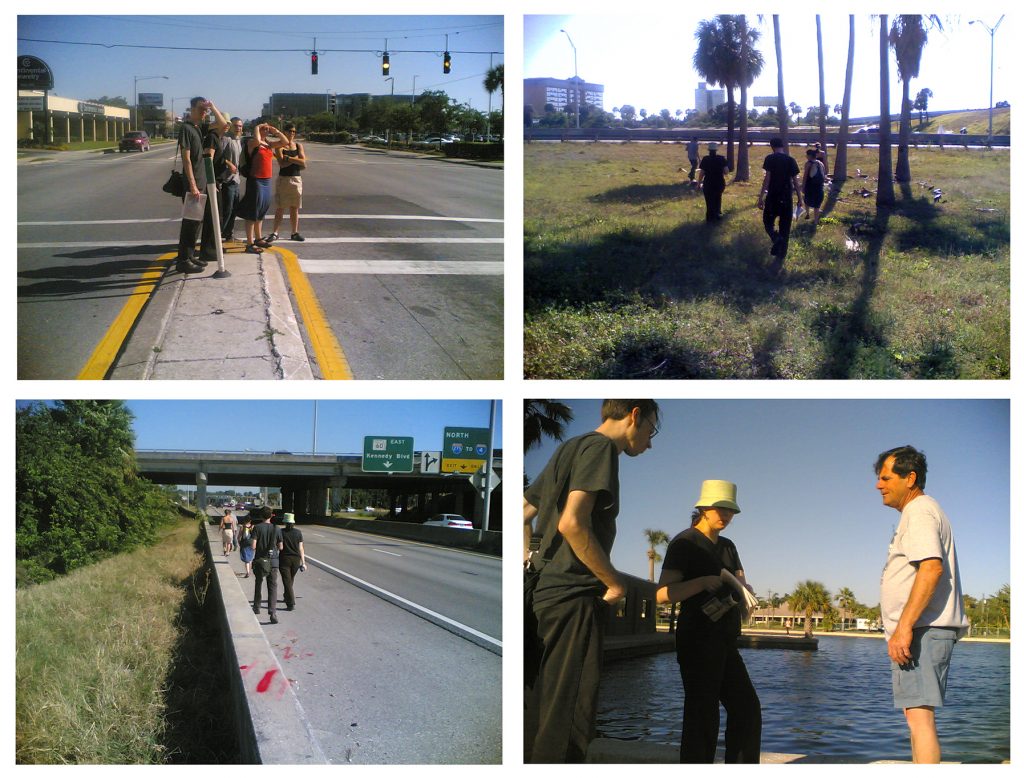
“In a city built around the logic of automobility, a small group documents several attempts to walk to Tampa’s last remaining public beach. We rely on instructions from passers-by who struggle to conform their mental map of the city to the possibilities of walking.” [credit]
From the original invite: ”
Kara Holland invites participants on a walk from the Westshore Palms neighborhood to the beach located directly west, less than 1 mile away. This public beach is one of the last few remaining in the city of Tampa. We will try to get to the beach on foot, navigating terrain that, not unlike much of the city, is hostile to walking. The walk will explore the ways in which otherwise “benign” structures (a corporate park, a mall, the highway and so forth) are aggressive to bodies not trapped in cars and effectively colonize public space. Participants will pause to mark especially hostile boundaries, using materials found on site. We will share a picnic upon arriving at the beach, or wherever we can no longer travel on foot. Recording devices for documenting the walk are welcome and encouraged (cell phone, cell phone camera, digital camera, video camera, audio recorder, etc). This walk is a collaboration with The Center For Getting Ugly as part of the “Walk, Talk, Eat, Talk Some More” project.
Date: April 15, 4:30 pm
Meeting place: Kara’s apartment, 4601 Gray St. Tampa FL, 33609
Duration: 2 hours (??)” [credit]
“Center for Getting Ugly – dedicated to the research, practice and sustained experimentation with conflict as essential political activity. the Center seeks to develop individual and collective capabilities for the production of radical politics. must embrace conflict as an essential, productive aspect of collaboration. must be perpetually dissatisfied with, and suspicious of, existing aesthetic or semantic strategies.
…
The Center for Getting Ugly is dedicated to the research, practice and sustained experimentation of social conflict, with the goal of encephalizing collective organs and social technologies for the production of radical politics. In other words, the Center operates on the premise that, given sufficient practice, we can develop collective revolutionary organs. The Center is not a group, a project or a place, but an open infrastructure. Its various subdivisions target specific practices or arenas for the production of critical deviance, with collective activity as its main underlying principle.
The Center for Getting Ugly launches invitations, provocations. it facilitates collaboration between multiple practitioners. it imagines, invents and sometimes even deploys probing devices. currently, its subdivisions are:
Can’t we all just get along? Counter-Cartographies of Playing Nice – invited or self-appointed Special Fellows conduct research on dominant modes of subjectivation in various concrete situations. though not all maps take the form of two dimensional representations, the desire is to produce interpretive works which may be used to incite, illuminate or facilitate intervention.
Walking and not Walking – develops extended skill-sharing, experimental workshops specifically focused on walking practices – and, given the ways in which mobility is structured around consumption and other forms of subjectivation, on practices of not walking: standing, stopping, pausing, staying and occasionally lying down.
A Synchronized Swimming – Different collectives are invited to design an un-resolvable conflict equation based on their own, unique working methods. These equations are passed on to another collective, who develop interpretive extensions/models for the sustension of conflict. A Synchronized Swimming then dives into the Pool: an exhibition/symposium/forum for incorporating these models into action.”
SOURCES:
- Archived “Common Places” blog and Flickr stream
Dillon de Give, The Coyote Walks (2009-2017)
- Dillon de Give, The Coyote Walks (2009-2017)
- Dillon de Give, The Coyote Walks (2009-2017)
- Dillon de Give, The Coyote Walks (2009-2017)
“An annual walking project that illustrates a connection between New York City and the wild. It was originally performed to commemorate the spirit of “Hal”, a coyote who appeared in Central Park in 2006 and died shortly after being captured and re-released in the forest. The walk begins in the city and remains within sight of a coyote-like path for three days before ending in a relatively wild area. The Coyote Walk has run as an itinerancy, or walking residency since 2014.” [credit]
“It is collaborative research, a retreat (in an almost literal sense), or a mindful holiday. Prospective fellow walkers may share an interest in related subjects, such as urban planning, folk/visual/movement/social arts, biology or other natural sciences. Participants must be prepared for a strenuous walk (approx. 15 miles per day) and for sleeping outside. Please note, differently abled walkers are encouraged to be in touch.” [credit]
Additional images and writing www.coyotewalks.wordpress.com
“I grew up in the Southwest US (Santa Fe, NM— where coyotes are ever-present both as biological entities and as cultural signifiers). I witnessed this event in the media while living in New York City, and continued to think about it in the years following. I began to feel that a larger narrative was looming behind the topical debates. The incident threw the relationship of the city dweller and the natural world into relief. It wasnʼt an abstract suggestion of interconnection between the two; it was a (momentary) unmediated instance of collision– a moment of confusion for both. Hal disrupted a normal state of affairs by presenting himself as an embodiment of something external to our picture of daily life in an orderly civilization. In this he was as comedic as he was threatening. Was this a typical animal or an exceptional one? What was he thinking? And how, exactly, did he find his way into the city?
One way to try to understand this story was to guess about the geography of the journey. The most obvious geographic challenge is the channel of water that separates the island of Manhattan from the mainland of the Bronx– like a moat surrounding a castle. Adrian Benepe, the NYC Parks Commissioner at the time, publicly hypothesized that Hal crossed a small Amtrack trestle bridge over the Spuyten Duyvil Creek at the northern tip of the Manhattan. This became a prevailing theory, but not the only possible one. Other scenarios were equally possible. For example, if Hal had utilized the long Bronx River corridor as a path, he might have crossed over the Harlem River further south and east. Because there were few eyewitness accounts, no camera traps, and no DNA analysis done on Hal, the definite crossing location will remain unknown. This crossing is a big plot point of the story as presented in the media. It came to stand for the dramatic moment in which a cunning trickster privately transgressed from the natural world into the human world. Looking closely at possible routes however, it becomes clear that there were many such crossings.
The Coyote Walks are fueled by curiosity about what it would mean to cross over the line between “the city” and “nature” oneself, to literally connect the two places. The walks are guesses about how coyotes enter New York City that are made with reverse human journeys out of the city. The project began as a kind of memorial to the incident— walked around the anniversary of Hal’s death and initially called the “laH” journey, a backwards spelling of the name. The Coyote Walk is now a time to pose questions about urban life and nature, to learn from the experience of stepping away from the city, and to consider walking practices (human and animal) as imaginative acts.” [credit]
Artist writing:
-
Unpacking (after) a coyote walk. Walking Lab residency, 2017. Link.
-
Connective filaments, coyote walks on the map. Living Maps Review No. 2, 2017.
Link / Download PDF -
Tracking the call of the wild from the heart of Manhattan. NYNJ Trailwalker Summer 2012. Download PDF
Speaking:
-
Artists and the Post Industrial Urban Wilderness, Union Docs, 2017. Link
-
Chance Ecologies Symposium, Queens Museum, 2016. Link
-
Re-inscribing the City: Unitary Urbanism Today, Anarchist Book Fair, 2011. Link
Referenced:
-
Urban Coyotes Spur Walks on the wild side. CUNY NYCity News Service. Audio piece by Samia Bouzid
-
“‘Uurga shig’ – What is it like to be a lasso?” Hermione Spriggs, Journal of Material Culture, 2016. Link
-
Out Walking the Dog blog, Melissa Cooper 2011-12. Link
-
City Reliquary event write up in Matt Levy’s Action Direction blog, 2009. Link
Hamish Fulton, A Walk Around the Block (2010)
This work utilizes equal spacing between each walker – a concept Fulton explored in “Walk dance art co” created by Christine Quoiraud & Hamish Fulton, at Chamarande in 2002 (with 23 other artists).
“At the corner of Bogie Street and Church Street, we get our instructions for today’s choreographed walk. For the next two hours, about 30 of us will walk repeatedly around the same block. We will walk in single file, maintaining a two-metre distance from the person in front. We will not talk.
So the focus of my attention for the next two hours are the heels of Allan Watson, course leader in sculpture at Gray’s School of Art. He’s taller than me, and there are moments when I have to jog to keep two metres between us. Passers-by stop to stare or snigger at this kenspeckle procession. By the fifth circuit, my calf muscles are screaming.
But by the tenth, something strange has happened. My legs don’t hurt anymore. My mind has relaxed. Time feels as if it is liquefying. Has it been ten laps, or 50? It doesn’t matter. I have no demands on my time, nothing is required of me but simply to walk. I wonder, briefly, if this is what it’s like to be Hamish Fulton.
Fulton is the artist who walks. For 40 years, he has made works of art exclusively relating to his walks. He has walked for thousands of miles in five continents. He has walked without sleep, got frostbite, climbed to 8,000m (26,246ft) without oxygen. He has got lost, been caught in storms, fallen down a crevasse (his rucksack wedged, allowing him to climb back out).
More recently, he has begun to choreograph walks involving groups of people, the idea of repetition inspired by the “Marathon Monks” of Mount Hiei in Japan, whose spiritual discipline involves running 40km (25 miles) a day on a repetitive circuit of the mountain. Focusing on the feet ahead of you becomes a secular meditation, a stilling of the mind. “It is a vehicle for a change of mind, a shift in where the mind’s located,” he says, carefully. “I think our minds go round and round and round in the same furrows, and possibly, when you do a walk like this, you go to another part of your mind. It sets in motion a variety of perceptions.
Fulton is in Huntly at the invitation of Deveron Arts, which invites world-class artists to run socially engaged projects in the town. The next day, some of the same walkers joined him on the first day of a 21-day walk in the Cairngorms. Over half a pint of lager in the Huntly Hotel, Fulton reflects that, of all the obstacles he has had to overcome in a lifetime of walking, he has never before been marooned by a cloud of volcanic ash (he eventually arrived by train after his flight to Scotland was cancelled). “It’s incredible, isn’t it? I know it’s costing so much loss of income for lots of people, so I’m sorry for that, but there is something… inspiring about it.
“We see the world in terms of us being able to build everything and make everything. But there are these other things, like volcanos, that we didn’t build. In these times, it’s pretty strange there is this other force, because we’re so used to pushing buttons and Googling data about something.”
Fulton was a contemporary of Richard Long and Gilbert & George at Central St Martins College of Art in the 1960s. He grew up in Newcastle, and his formative experiences of walking were on family holidays to Arran. He was profoundly influenced by a visit to the United States in 1969, when he walked at the site of the Battle of Little Bighorn in Montana and read the work of Native American Luther Standing Bear, who wrote in the 1930s about the Sioux relationship with the Earth. In terms of art, it was an era of exploding potential: art happened outside museums; art was experience; art could be a walk.
The ideas which crystallised at that time have remained consistently central to Fulton’s work. Unlike Richard Long or an artist such as Andy Goldsworthy, he makes no work in the landscape and takes nothing away. The work he makes afterwards – often using photography and graphic text – reflects the walk but cannot reproduce it. The walk and the work are separate creative acts. His work is evocative, but minimalist; Japanese haiku poetry is a key influence. A walk in Wyoming’s Wind River range became just two words: CLOUDS STONES. A road walk across Spain and Portugal is WARM DEAD BIRD. Seven days in the Pyrenees is simply RAIN.
By the time you read this, Fulton will have been in the Cairngorms for four days, carrying his tent, food and fuel. He has no plan, other than to arrive at Glenmore Lodge exactly 21 days after he set out. He will not film or webcast his trip. What happens in the mountains is a mystery, though prosaic details do slip out: one of the most important tools for a serial walker is his nail-clippers. Short toenails are essential for comfort.
“The Cairngorms are like a person, I’m very fond of them. And, of course, anywhere like that is always threatened. So much of the world is either factory, agriculture, roads or housing, as time goes by these spaces are more and more unusual.
“I make the plan up as the days go by, which is extremely luxurious when everything in life has to be so controlled and planned. And then you have loss of control – someone sends you an e-mail, and you have to reply immediately, and then you realise that they sent their e-mail late. All this absurd behaviour that we just slip into.” Stepping into the unknown is a key component. “That’s the difference between making a geometric painting, where you’re fulfilling the plan, and something like this where you’re casting off, and you genuinely don’t know what the outcome can be. It could be a fall, or a wonderful sunrise; you don’t know.”
Fulton is not shy of being political. He is concerned about climate change, but speaks of the need for a profound shift in our relationship with the Earth, rather than simply incorporating a “green economy” into a money-driven system.
Last year, he organised a protest – a walk, of course – for Tibetan freedom, attended by Palden Gyatso, a Tibetan monk imprisoned by the Chinese for 33 years. A recent wall painting bears the words: “GOOGLE PALDEN GYATSO”. Those who do will find a story of torture and endurance. But in China, the link is blocked.
Last May, at the age of 62, Fulton reached the summit of Everest. An artist’s book about his journey will be published this summer. After a lifetime of walking, he was on top of the world.
“It is doing something which is unbelievable. We want a lot of things we want to be unbelievable but they’re not really. In this case, this completely fulfils the objective of doing something that feels unbelievable. The reality doesn’t hit you until five days later.” With that behind him, a forecast of snow in the Cairngorms is hardly a concern. The walking philosopher just shrugs, smiles and heads off into the unknown, one step at a time.” [credit]
Norma Hunter, Walk this Way (2010)
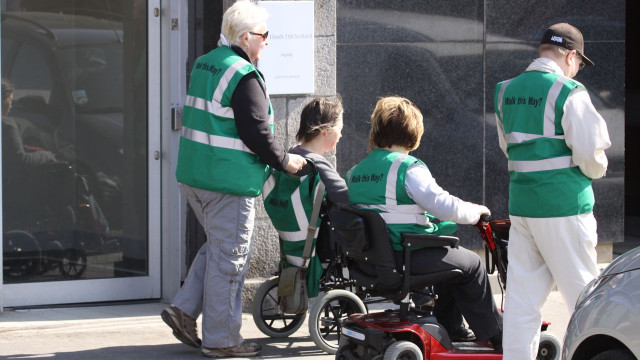
Norma Hunter, Walk this Way (2010) [credit]
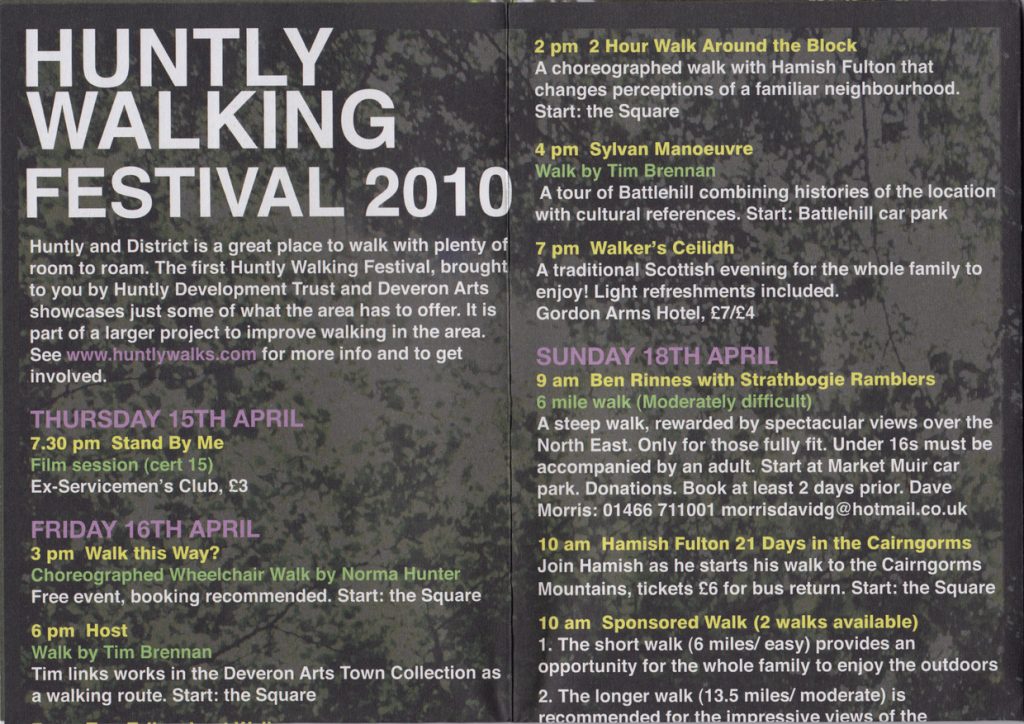
Andrea Carlson, You Are on Potawatomi Land (2021)
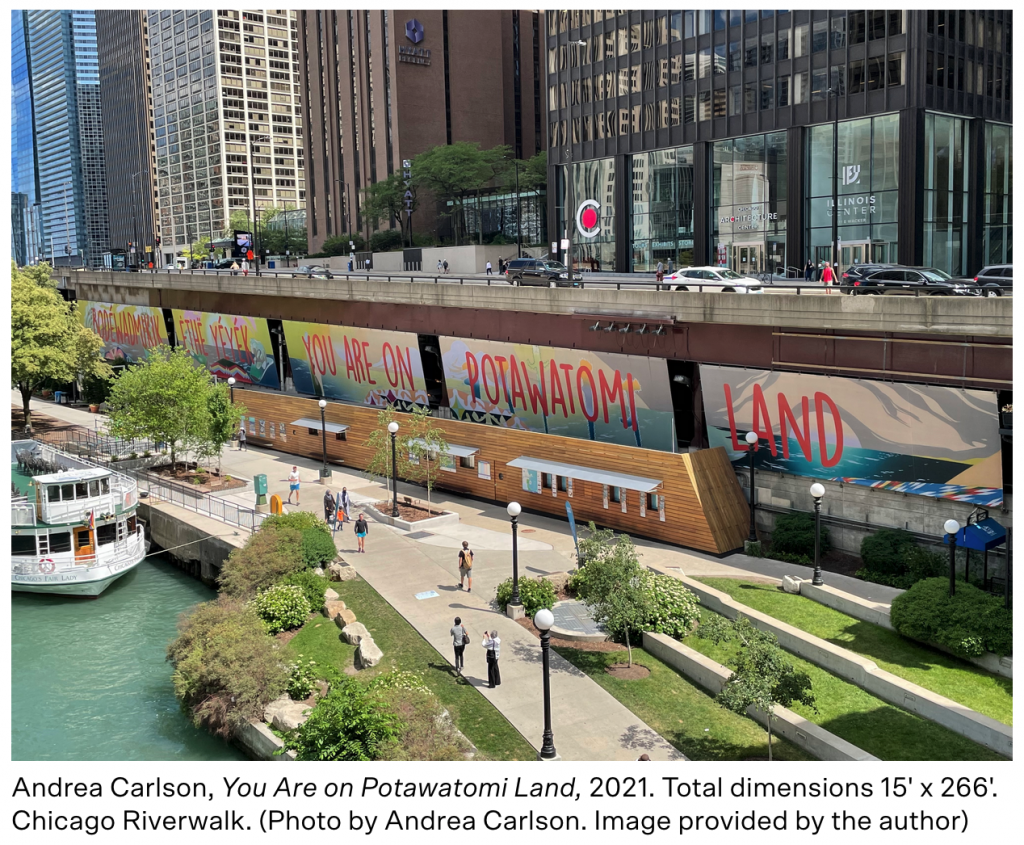
[credit]
Credits: Lee, JeeYeun. “Don’t Look to My Work for Reconciliation”: A Conversation with Andrea Carlson,” Monument Lab. Accessed February 13, 2022: https://monumentlab.com/bulletin/dont-look-to-my-work-for-reconciliation-a-conversation-with-andrea-carlson
Michel de Certeau, “Walking in the City” from The Practice of Everyday Life (1980)
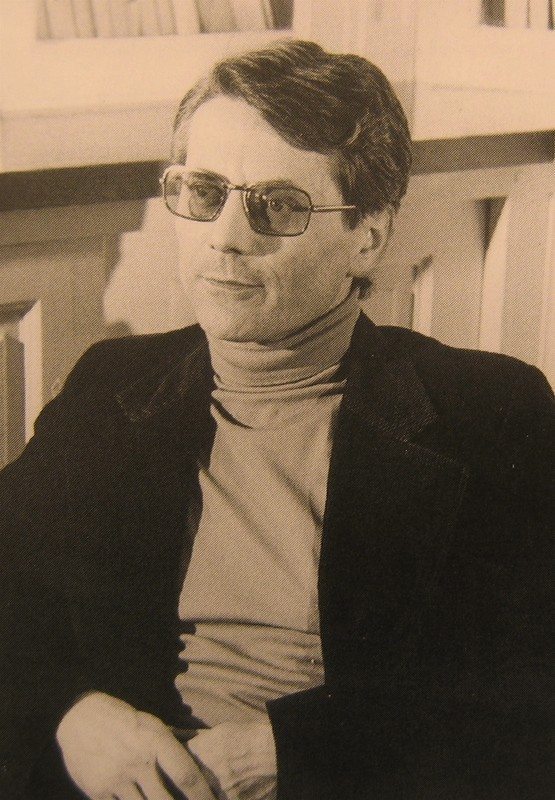
Michel de Certeau – French Jesuit philosopher and social theorist (1925-1986)
Certeau is often referenced for his essay, “Walking in the City,” in The Practice of Everyday Life (1980).
In this essay he elaborates on an analogy between urban systems and language, with improvisational walking (shortcuts, wandering, etc) being like turns of phrase, inside jokes, or stories. He states, “The act of walking is to the urban system what the speech act is to language or to the statements uttered.”
He describes the city as “a space of enunciation,” where walkers demonstrate possibilities through their walking choices. He states, “The walking of passers-by offers a series of turns and detours that can be compared to ‘turns of phrase’ or ‘stylistic figures.’ There is a rhetoric of walking.”
Jonathan L. Best writes a nice analysis of the essay here.

